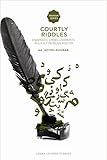Courtly Riddles : Enigmatic Embellishments in Early Persian Poetry / Asghar Seyed-Gohrab.
Material type: TextSeries: Iranian Studies SeriesPublisher: Leiden : Leiden University Press, [2010]Copyright date: 2010Description: 1 online resource (228 p.)Content type:
TextSeries: Iranian Studies SeriesPublisher: Leiden : Leiden University Press, [2010]Copyright date: 2010Description: 1 online resource (228 p.)Content type: - 9789400600102
- 891.551109
- PK6412.R53 S49 2010
- online - DeGruyter
| Item type | Current library | Call number | URL | Status | Notes | Barcode | |
|---|---|---|---|---|---|---|---|
 eBook
eBook
|
Biblioteca "Angelicum" Pont. Univ. S.Tommaso d'Aquino Nuvola online | online - DeGruyter (Browse shelf(Opens below)) | Online access | Not for loan (Accesso limitato) | Accesso per gli utenti autorizzati / Access for authorized users | (dgr)9789400600102 |
Frontmatter -- Table of Contents -- Acknowledgments -- PART ONE -- Chapter One. The Eloquent Mute -- Chapter Two. Inimitable Simplicity -- PART TWO -- Chapter Three. “Words Covered in Veils” -- Chapter Four. “A Nightingale without feathers” Riddlers of the Late Ghaznavid and Early Seljuq Periods -- Chapter Five. The Virtues of the King: Riddles in Mukhtærñ’s Hunar-næma -- Conclusion -- References -- Index
restricted access online access with authorization star
http://purl.org/coar/access_right/c_16ec
This book is the first study of Persian literary riddles to appear in English, analysing a wide range of complex riddling poems systematically from the tenth to the twelfth century. In addition to the genre of riddles, the book examines the relationship between metaphors and riddles and the genre of literary description. Riddles belong to the oldest genre in many literary traditions. Riddles were composed at courts in the Iranian world for various purposes, such as highlighting the courtly insignia that refer to the ruler’s administrative and military power. The aesthetic of puzzlement was much appreciated at courts. Through a riddle, the poet aims to demonstrate his artistic accomplishment in a short space; and at the same time he secures his social, professional and personal position at the court and in cultured circles. Literary riddles occur in the early specimens of Persian literature from the tenth century and they continue to be used in modern Iranian society.
Mode of access: Internet via World Wide Web.
In English.
Description based on online resource; title from PDF title page (publisher's Web site, viewed 26. Aug 2024)


